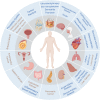The double-edged role of neutrophil heterogeneity in inflammatory diseases and cancers
- PMID: 37492784
- PMCID: PMC10363828
- DOI: 10.1002/mco2.325
The double-edged role of neutrophil heterogeneity in inflammatory diseases and cancers
Abstract
Neutrophils are important immune cells act as the body's first line of defense against infection and respond to diverse inflammatory cues. Many studies have demonstrated that neutrophils display plasticity in inflammatory diseases and cancers. Clarifying the role of neutrophil heterogeneity in inflammatory diseases and cancers will contribute to the development of novel treatment strategies. In this review, we have presented a review on the development of the understanding on neutrophil heterogeneity from the traditional perspective and a high-resolution viewpoint. A growing body of evidence has confirmed the double-edged role of neutrophils in inflammatory diseases and tumors. This may be due to a lack of precise understanding of the role of specific neutrophil subsets in the disease. Thus, elucidating specific neutrophil subsets involved in diseases would benefit the development of precision medicine. Thusly, we have summarized the relevance and actions of neutrophil heterogeneity in inflammatory diseases and cancers comprehensively. Meanwhile, we also discussed the potential intervention strategy for neutrophils. This review is intended to deepen our understanding of neutrophil heterogeneity in inflammatory diseases and cancers, while hold promise for precise treatment of neutrophil-related diseases.
Keywords: cancers; inflammatory diseases; neutrophil extracellular traps; neutrophil heterogeneity; single‐cell sequencing.
© 2023 The Authors. MedComm published by Sichuan International Medical Exchange & Promotion Association (SCIMEA) and John Wiley & Sons Australia, Ltd.
Conflict of interest statement
The authors have no conflicts of interest to declare.
Figures






Similar articles
-
Neutrophil plasticity in the tumor microenvironment.Blood. 2019 May 16;133(20):2159-2167. doi: 10.1182/blood-2018-11-844548. Epub 2019 Mar 21. Blood. 2019. PMID: 30898857 Free PMC article. Review.
-
Neutrophils in Inflammatory Diseases: Unraveling the Impact of Their Derived Molecules and Heterogeneity.Cells. 2023 Nov 13;12(22):2621. doi: 10.3390/cells12222621. Cells. 2023. PMID: 37998356 Free PMC article. Review.
-
Targeting neutrophil extracellular traps: A novel strategy in hematologic malignancies.Biomed Pharmacother. 2024 Apr;173:116334. doi: 10.1016/j.biopha.2024.116334. Epub 2024 Feb 29. Biomed Pharmacother. 2024. PMID: 38422658 Review.
-
Neutrophil extracellular traps: Their role in periodontal disease.J Indian Soc Periodontol. 2014 Nov-Dec;18(6):693-7. doi: 10.4103/0972-124X.147399. J Indian Soc Periodontol. 2014. Retraction in: J Indian Soc Periodontol. 2015 Mar-Apr;19(2):128. doi: 10.4103/0972-124X.154336. PMID: 25624623 Free PMC article. Retracted. Review.
-
The double-edged role of neutrophil extracellular traps in inflammation.Biochem Soc Trans. 2019 Dec 20;47(6):1921-1930. doi: 10.1042/BST20190629. Biochem Soc Trans. 2019. PMID: 31754705 Review.
Cited by
-
Multiorgan proteomic analysis of infected animal models predict potential host factors for chikungunya virus.MedComm (2020). 2025 Jan 3;6(1):e70013. doi: 10.1002/mco2.70013. eCollection 2025 Jan. MedComm (2020). 2025. PMID: 39764561 Free PMC article.
-
Inwardly rectifying potassium channels regulate membrane potential polarization and direction sensing during neutrophil chemotaxis.bioRxiv [Preprint]. 2025 Mar 6:2025.03.06.641746. doi: 10.1101/2025.03.06.641746. bioRxiv. 2025. PMID: 40093039 Free PMC article. Preprint.
-
Target neutrophil heterogeneity and plasticity in cancer.J Hematol Oncol. 2025 Aug 12;18(1):79. doi: 10.1186/s13045-025-01731-0. J Hematol Oncol. 2025. PMID: 40797279 Free PMC article. Review.
-
The emerging role of neutrophil extracellular traps in autoimmune and autoinflammatory diseases.MedComm (2020). 2025 Mar 6;6(3):e70101. doi: 10.1002/mco2.70101. eCollection 2025 Mar. MedComm (2020). 2025. PMID: 40060194 Free PMC article. Review.
-
Immune suppressive activities of low-density neutrophils in sepsis and potential use as a novel biomarker of sepsis-induced immune suppression.Sci Rep. 2025 Mar 19;15(1):9458. doi: 10.1038/s41598-025-92417-7. Sci Rep. 2025. PMID: 40108283 Free PMC article.
References
Publication types
LinkOut - more resources
Full Text Sources
